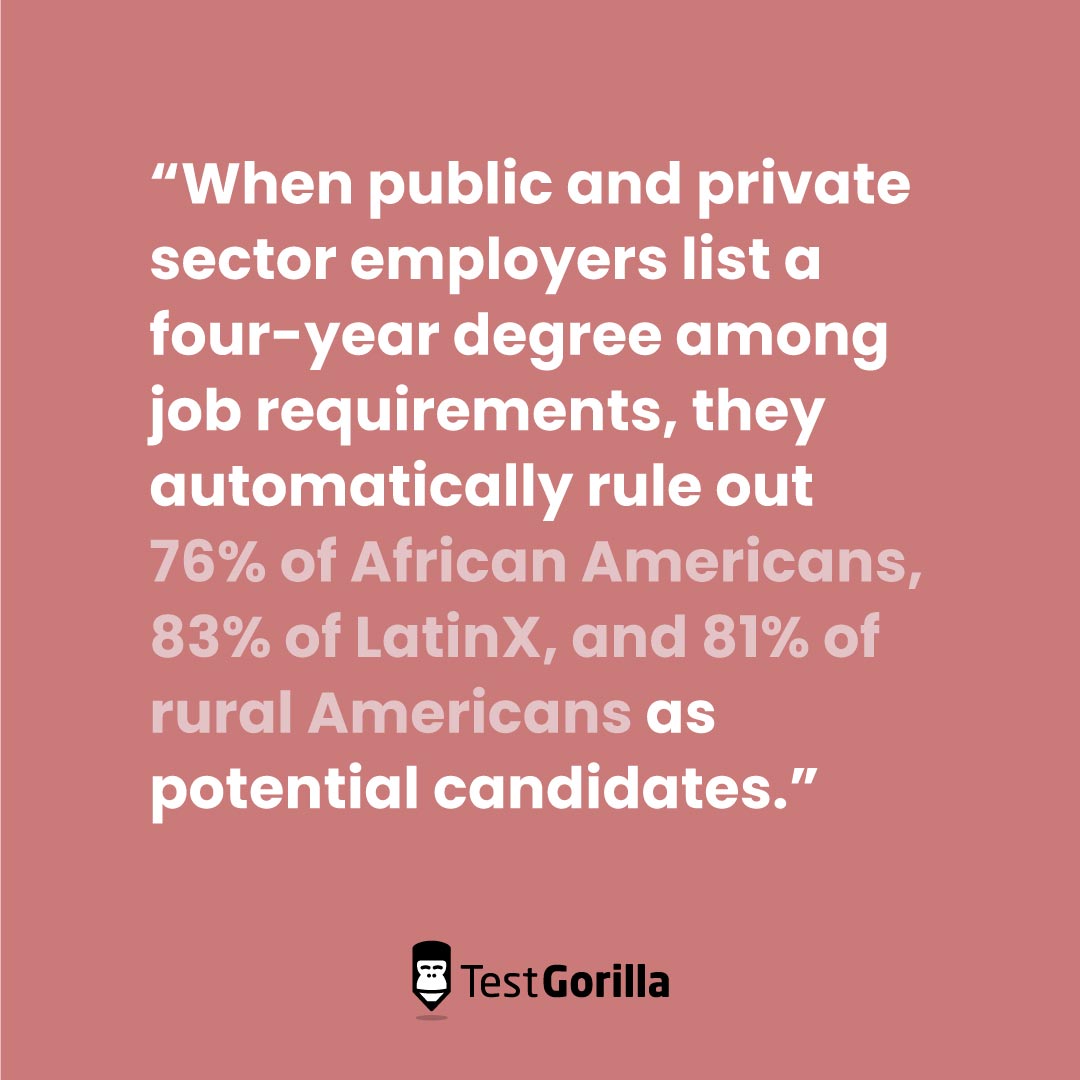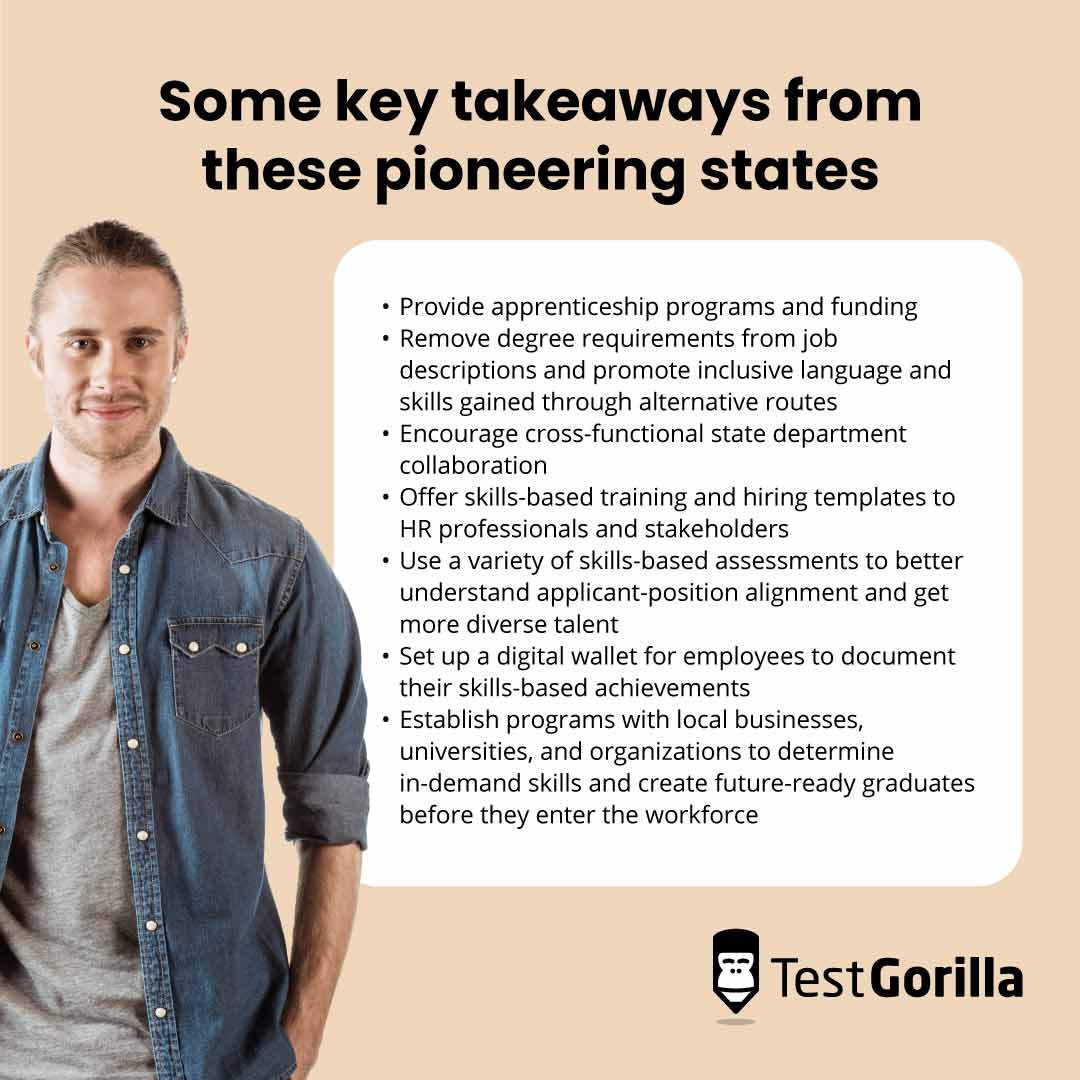Skills-based hiring is the latest US hiring trend – and these 5 states are getting it right
States across the US are implementing a skills-based approach to hiring and rewriting the rules to traditional hiring practices.
Instead of evaluating candidates on their education and background, they’re going in search of diverse talent who have the skills needed for the job. This opens up opportunities to people who might miss out because they’ve been skilled through alternative routes (STARs) or don’t have a degree.
However, not all states are created equal in their approaches to hiring and progress.
In this piece, we look at how five US states are adopting skills-based hiring and what you can learn from them to attract the best talent for your own business.
From college degrees to a skills-based approach
A growing skills gap, digital poverty, and an education system that prioritizes theory over practical skills have all contributed to the current big demand for, and seemingly short supply of, skilled talent.
To keep up with new trends in occupational mobility and level the playing field for underserved communities, employers need fairer ways to measure the skills of their applicants. That means getting rid of degrees as an essential requirement for employment.
When public and private sector employers list a four-year degree among job requirements, they automatically rule out 76% of African Americans, 83% of LatinX, and 81% of rural Americans as potential candidates.[1] As a result, companies are less likely to access top talent for their open roles and aren’t cultivating a diverse workforce or company culture.
According to Stephanie Short, VP of partnerships at America Succeeds:
The reality is that organizations and employers talk about the talent shortage constantly. It does not matter if you’re in the public or private sector, recruiting the right talent is a challenge. The solution is skills-based hiring: Removing the college-degree requirements and opening up the talent pool to the millions of qualified, skilled workers currently hidden behind that unnecessary barrier.
Stephanie Short, VP of partnerships at America Succeeds
With skills-based hiring, you can better attract and retain the workforce you need. You also get access to diverse candidates who might have been otherwise overlooked. This is especially important because ethnically diverse teams are 36% more likely to financially outperform non-diverse teams, while gender-diverse teams are 25% more likely.[2]
5 US states at the forefront of the skills-based hiring movement
We interviewed Stephanie Short about the stages of rolling out a skills-based approach to hiring.
It turns out that removing degree requirements is only the first step in adopting a skills-based approach to recruiting.
The second, much harder step, is going through those jobs and identifying the true skills and competencies needed to be successful in those roles. And then finding ways to validate those skills and competencies that are relevant to job performance. Ways that aren’t violating the mess of federal regulation that exists around this space.
Stephanie Short, VP of partnerships at America Succeeds
Congresswoman Elise Stefanik has proposed legislation in support of skills-based hiring.[3] However, the current lack of cohesive federal oversight and regulation ultimately leaves states to come up with their own blueprint for skills-based hiring by industry and skills-based hiring by role. Below we explore the various steps different states are taking to hire for skills, and how it might help them win the war for talent.
1. Colorado
Colorado is at the forefront of removing employment barriers and improving workforce development. It uses skills-based hiring to help fill its workforce needs and digital skills gaps, as well as open its talent pool to minorities and people with disabilities.
Governor Jared Polis signed an executive order in April 2022 in support of state agencies that prioritize the knowledge, skills, and abilities specific to open jobs.[4] This is a marked change from their previous hiring policy, which relied on postsecondary degrees and credentials as a baseline requirement for employment.
According to Colorado Succeeds, 76% of Colorado employers would increase employee compensation and 84% would create more jobs if there wasn’t a skills gap.[5]
Here’s how Colorado’s Division of Human Resources is promoting skills-based hiring and closing the skills gap:
Providing resources and training on skills-based hiring practices for human resources professionals to include in the selection processes.
Offering a skills-based selection plan template for agencies.
Partnering with the Department of Labor and Employment to integrate work-based learning models (like apprenticeships) into skills-based hiring training.
Using a data-driven approach to monitor and evaluate program success and identify all positions eligible for a skills-based approach.
Ensuring all job postings include skills requirements as a replacement for educational requirements – except for highly specialized positions – by the end of 2024.
The Governor’s budget of $700,000 will help pay for the transition with money set aside to train hiring managers, update regulations, and develop a standardized skills-based hiring toolkit for state departments.
2. Utah
Utah’s Department of Workforce Services has partnered with businesses, schools, and other organizations to make sure students are learning in-demand skills needed by local businesses. This has helped Utah improve employee retention, address skills gaps, and create a more diverse and skilled workforce.[6]
The state has also partnered with LinkedIn to launch the Skillful Utah Talent Marketplace. The platform helps workers find jobs that align with their skills and helps employers identify the best candidates for the role. The platform also provides resources for job seekers to develop and showcase their skills.
In addition, the Utah Job Skills Partnership (UJSP) provides grants to businesses for training programs. These improve current workers’ skills and help prepare people for new jobs.
Governor Cox also eliminated bachelor’s degree requirements in Utah, which has widened access to qualified talent and expanded employment opportunities to attract diverse candidates.
“Degrees have become a blanketed barrier to entry in too many jobs,” Governor Cox said. “Instead of focusing on demonstrated competence, the focus too often has been on a piece of paper. We are changing that.”
3. Maryland
Maryland relies on skills-based hiring to address skills gaps in high-demand industries and provide opportunities for people to develop their professional abilities.
The state of Maryland launched a first-in-the-nation initiative to formally eliminate four-year degree requirements from thousands of state jobs. It creates job opportunities for previously overlooked job seekers with in-demand skills who are lacking college degrees.
Stephanie Short, VP of partnerships at America Succeeds
Maryland also has several registered apprenticeship programs in industries such as healthcare, construction, and advanced manufacturing to reskill and upskill employees. These programs combine on-the-job training with coursework to help people develop job-specific skills. In addition, the state offers tax credits to businesses that hire apprentices and funding to support the development of new apprenticeship programs.
Another example of Maryland striving to use skills-based rather than traditional hiring practices is its WorkSmart program, which helps people find opportunities based solely on their skills.
After broadening job requirements to include and accept ‘equivalent practical experience’ in more than 300 state job ads, Maryland saw a 41% increase in new hires with the right skills and without degrees.[7]
4. Pennsylvania
Pennsylvania has struggled to attract skilled workers in recent years due to a combination of factors. These include a lack of investment in technology education and a mismatch between workforce skills and the skills employers require.
In an effort to increase interest and employment opportunities in the public sector, Governor Josh Shapiro recently signed an executive order to remove degree requirements for roles in local government.
The order requires state agencies to ask about prior work experience and skills in their job listings, instead of education. This way, Pennsylvania hopes to fill approximately 65,000 state jobs through:
Apprenticeships
0n-the-job training
Military training
Trade schools
Pennsylvania also has a program called Industry Partnerships, which provides grants to businesses to develop skills-based training programs and prioritizes training programs based on industry-recognized certifications or credentials.
The Pennsylvania Workforce Development Association helps job seekers find opportunities based on their skills and competencies. Pennsylvania also has an Apprenticeship and Training Office that develops and promotes apprenticeship programs in high-demand industries.
5. Indiana
To win tech sector talent and prevent outdated and biased hiring, Indiana is working on creating a common language around the skills required by different sectors.
To do this, the state is looking at current degrees offered in the community college system and how they relate to specific career pathways. From there, candidates can create a digital wallet or an ‘Indiana Achievement Wallet’ that translates courses and degrees into applied, in-demand skills.
A skills-based digital wallet lets you store and access information related to your skills and competencies. By tracking and documenting learning and training activities, this tool can provide personalized recommendations for new skills and learning opportunities. This helps workers stay relevant and competitive in a rapidly changing job market.
Basically, at a state level [they’re] thinking about how skills and competencies stack up over time and have created a learning and employment record that individuals can carry with them. And the state can then provide credibility to those credentials.
Stephanie Short, VP of partnerships at America Succeeds
Indiana has also created a task force that brings together leaders from government, education, and business to develop strategies to strengthen the state’s workforce. Additionally, the Skillful Indiana program provides relevant training and resources to workers and employers, including career coaching, job-matching services, and educational opportunities.
The best insights on HR and recruitment, delivered to your inbox.
Biweekly updates. No spam. Unsubscribe any time.
What we can learn from these pioneering states
Skills-based hiring around the world and across the US will differ as laws try to keep up with shifting skills demands and technology. However, there’s still a lot to learn from these pioneering states.
Here are some takeaways:
Provide apprenticeship programs and funding. For example, the Utah Apprenticeship Program focuses on competency-based education. Instead of requiring apprentices to complete a set number of hours or years in the program, the program measures apprentices’ progress based on their mastery of specific skills and competencies, helping them overcome the digital skills gap.
Remove degree requirements from job descriptions and promote inclusive language and skills gained through alternative routes.
Encourage cross-functional state department collaboration. For example, Colorado’s Division of Human Resources partnership with the Department of Labor and Employment.
Offer skills-based training and hiring templates to HR professionals and stakeholders.
Use a variety of skills-based assessments to better understand applicant-position alignment and get more diverse talent.
Set up a digital wallet for employees to document their skills-based achievements.
Establish programs with local businesses, universities, and organizations to determine in-demand skills and create future-ready graduates before they enter the workforce.
In terms of next steps and what skills-based hiring could look like in the future, Stephanie Short says:
“[It’ll require] a really scaled level of personalization. For the workforce, that means getting to a place where we can identify and value every individual’s unique strengths and skills. We can then allow them to leverage those skills and strengths into their version of success — and connect them to more of those opportunities.”
Use skills-based hiring for state-wide recruitment success
Skills-based hiring is helping states across the US close the skills gap, find and retain top talent, and create more productive and diverse teams.
States like Colorado, Utah, Maryland, Pennsylvania, and Indiana are leading the way for skills-based hiring practices and creating a fairer way to source talent. All of which helps better match workers to opportunities, while creating a culture that makes people want to work at your company, and more importantly, stay there.
More US states should follow suit to address the growing digital skills gap and win the war for talent. By implementing a skills-based approach to recruitment, local governments can significantly increase employment rates and improve the quality of their workforce and output.
In Stephanie Short’s words, “by emphasizing skills-based education and hiring, every learner has the opportunity to find their own meaningful and fulfilling pathway that contributes to the world and their community.”
Want an easy way to hire for skills? Skills-based hiring lets you get in front of top talent with all the right skills — and win the talent war. Download the State of Skills-based Hiring 2022 report to learn more.
Sources
“Hire for the Skills It Takes to Do the Job”. (n.d.). Opportunity @ Work. Retrieved March 10, 2023. https://opportunityatwork.org/wp-content/uploads/2019/12/Skills-Based-Hiring.pdf
“Diversity wins: How inclusion matters”. (2020) McKinsey & Company. Retrieved March 10, 2023. https://www.mckinsey.com/featured-insights/diversity-and-inclusion/diversity-wins-how-inclusion-matters
“Stefanik Introduces Legislation to Support Skills-Based Hiring During Labor Shortage”. (2022). Elise Stefanik, US Congress. Retrieved March 10, 2023. https://stefanik.house.gov/2022/9/stefanik-introduces-legislation-to-support-skills-based-hiring-during-labor-shortage#:~:text=September%2029%2C%202022,and%20abilities%20over%20college%20degrees.
“EXECUTIVE ORDER Concerning Skills-based Hiring for the State”. (2022). The State of Colorado. Retrieved March 10, 2023. https://drive.google.com/file/d/1Oc0sg592hQFiAp-dVmA1ugvtwE8GRNZu/view
“Skills Gap – Improve Education and Talent (2018)”. Colorado Succeeds. Retrieved March 10, 2023. https://coloradosucceeds.org/best-schools/skills-gap/
“Why Skills-Based Hiring Is On The Rise”. (2023). Forbes. Retrieved March 10, 2023. https://www.forbes.com/sites/carolinecastrillon/2023/02/12/why-skills-based-hiring-is-on-the-rise/?sh=1b33725224a9
“We need more skills rather than degree-based hiring practices”. (2022). Washington Examiner. Retrieved March 10, 2023. https://www.washingtonexaminer.com/restoring-america/community-family/we-need-more-skills-rather-than-degree-based-hiring-practices
Related posts
You've scrolled this far
Why not try TestGorilla for free, and see what happens when you put skills first.
















